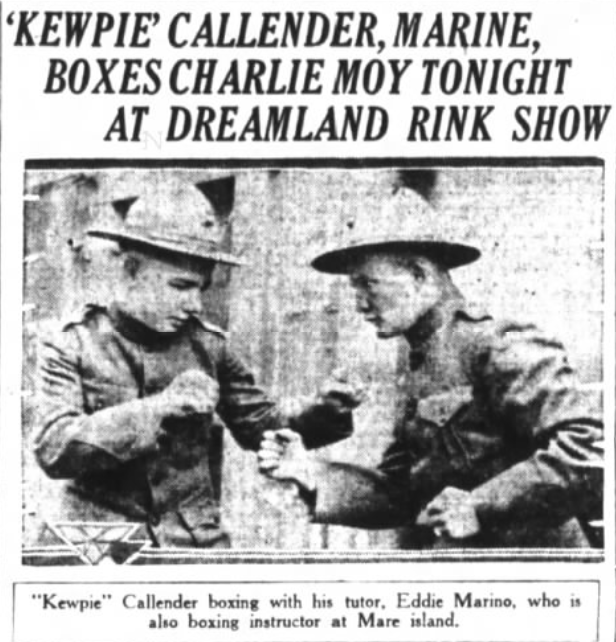FRED “KEWPIE” CALLENDER: MINNESOTA’S “OTHER KEWPIE”
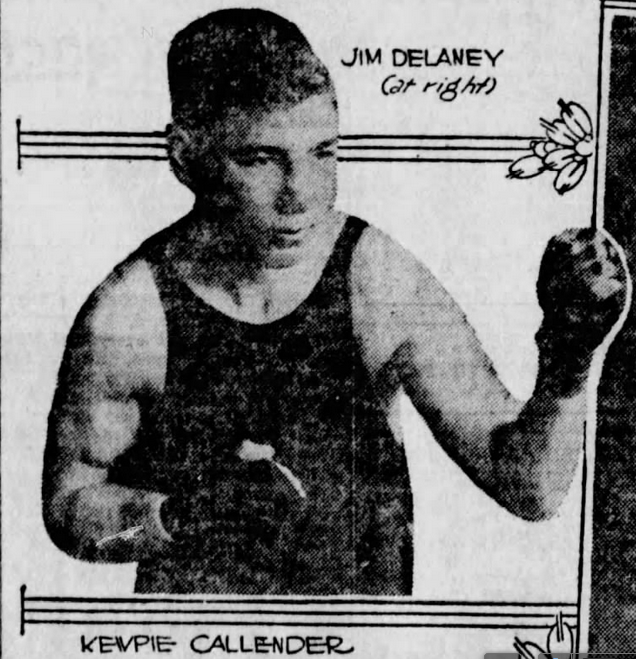
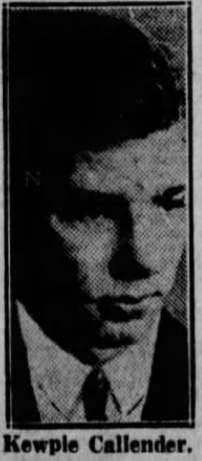
BY JAKE WEGNER When someone mentions the word, “Kewpie” in fistic circles in the land of 10,000 Lakes, most boxing aficionados automatically think of our first world champion, Johnny “Kewpie” Ertle, as they should. Ertle was a boxing dynamo, a miniature version of Mike Gibbons and famously won the world Bantam crown on a foul by Kid Williams in 1915 in St. Paul. But there was another baby-faced boxer, and one similar in weight too. Fred “Kewpie” Callender was a crack Bantamweight, who from 1918-1920, tore it up within his division, and later tore it up in the streets, ultimately meeting a most untimely demise. But he could fight, oh could he fight.
Fred Callender was always a man small in stature, but large in ring presence. His interest in boxing began by watching Johnny Ertle when boxing was relegalized in Minnesota in 1915. Callender loved it when folks commented on his doll-like face because it meant comparisons to Ertle. Callender joined the Marines during WWI and went to Mare Island, California where he began his professional boxing career. A fair amount of his early fights are missing from his record today, as evidenced by the many stories in old newspapers of that time period referencing a fair amount of bouts not presently documented on his boxrec profile.
While serving in WWI, world Lightweight champion, Benny Leonard, came to the coast and worked with pros stationed there in May of 1918, and Callender was among them. Kewpie went 2 hard rounds with the champ on a handful of occasions.
Many fight writers of the time thought Kewpie was a local California kid on account of his many West Coast battles and activities, yet this was never the case, as he even shared a Minnesota boxing manager in Tom O’Rouke, Fred Fulton’s manager of that time.
With only 2 recorded losses to his record, and those being to Charlie Moy and Billy Bevan, two fighters whose combined record when beating Callender was a whopping 66-26-10, Fred came home to Minneapolis and campaigned here and went on a tear, blowing out: Jack Stroud, Artie Shiere, Al Gordon, fellow rising star Joey Schwartz, and Benny Vogel. The little bantam was catching many headlines and had the attention of boxing reporters, George Barton and Fred Coburn.
In August of 1920, Canadian paper, “The Gazette” (Montreal), remarked on Callender rapidly becoming a contender for the Bantamweight title.

After losing a close one to Babe Asher in early October of 1920, Kewpie rebounded with a 3rd round KO over Jimmy Powers in New Jersey followed by a handful of more newspaper decisions before finally dropping a match to Harry Pelsinger in St. Louis, a veteran with close to 100 fights under his belt. Not long after this, Callender went back West, sometimes fighting under the alias Jimmy Callahan, and sometimes using his own, as cash began to be Kewpie’s main concern as he began hanging out more and more with his brother, a Minneapolis trouble-maker. When Fred had time to train, he fought as Kewpie. When he didn’t, he was Jimmy Callahan. Not exactly a scrupulous thing to do, but not unheard of in those days at all. But one did not have to look hard to learn of the beginning slide of Fred “Kewpie” Callender; not even in those days of print and radio only when it came to information. News of Kewpie’s partying ways and ditching out on training and even fights, were all too easy to hear of. This headline came from December of 1920 in the Minneapolis Star, and a few weeks afterward, he was suspended by the New York State Athletic Commission for failing to make appearances. Kewpie didn’t care. What was once the love of his life (boxing), was now just a way to fund his wild ways.
By 1921, Callender, hardly training, could no longer make his natural Bantamweight limits and began campaigning as a Featherweight, winning the majority of his fights in Missouri and California before really beginning to bottom out in 1923. After losing to Bud Hamilton, Callendar hung up the gloves with a respectable record of 29-14-8.
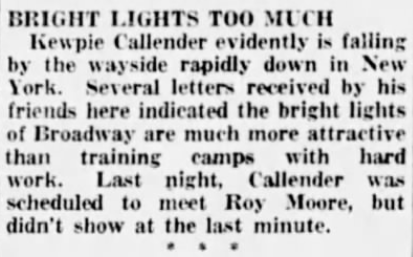
After nearly 5 years out of the ring, Callender attempted a comeback in May of 1927. He was to face Billy West at the Oak Park Arena in Stockton, California. He ended up with just a 4 round Draw verdict, but the papers did call it the best bout of the card. The fight chipped his tooth and required dental attention before facing Al Crisp, losing via TKO in the 5th and suffering a set of broken ribs in the process. All of this required him to take some time off before facing who would end up being his last ring opponent, Frankie Benjamin in February of 27’, a fight he would lose the newspaper verdict on. Although Callendar’s fistic career was over with a record of 29-16-9, his life of crime was just warming up…
Carroll, Metzger, Barry, Watson, Callahan, Callender…
In January of 28’, papers around the county ran an article on the little felon racking up charges in a handful of states, most recently, Montana. Using the alias, M.J. Watson, Fred was caught cashing a number of forged payroll checks from the Stephenson Lumber company. He was arrested and put in Butte jail. A few nights in the slammer was apparently too many, and he sawed his way out of the jail and stole a car belonging to the Lavelle Taxicab company and fled the city. After an exciting chase, Fred was shot in the right hand by one of the officers and they began to discover the true nature of who they were dealing with. It was found that he had first gotten into burglary in June of 1922 in Vallejo. He was later arrested in Colorado Springs in August of 23’ and then again in Utah under the name of James Von Metzger in March of 24’ for grand larceny and for robbing a man of $240 and a watch. Later under the name of Dean Barry, he was again arrested on August 20, 1925 for burglary in Elko, Nevada. He escaped a few months later and was caught in July of 1927 for forgery, and going by the name of Jimmie Carroll.
October 21, 1932…The End of the Line
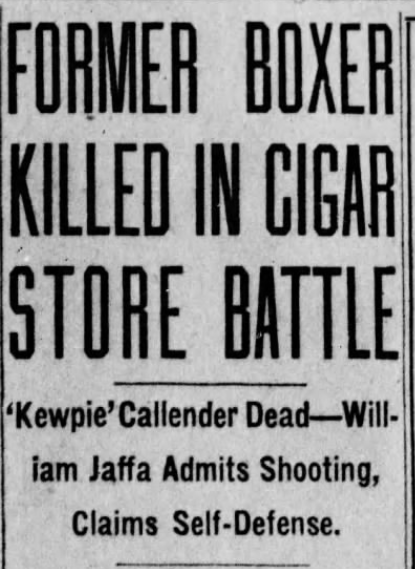
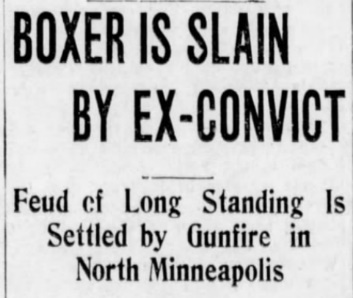
On October 21, 1932, Fate caught up with 32 year-old Kewpie Callender. He was hanging out with his brother, Eugene when he was fatally shot by William Jaffa in front of a Minneapolis cigar store. Jaffa never denied killing Kewpie and firing and injuring his brother, but claimed it was out of self-defense after Eugene, who was on a several day drinking binge and looking for more liquor, walked into the cigar store with a pistol and shouted, “This is a stickup”, after which Jaffa went for the gun which led to a struggle. The altercation occurred inside the Liberty Cigar Store, 1011 Sixth Avenue North. Kewpie later ran inside to help his brother, but Jaffa had managed to get the gun away from Eugene and was pistol-whipping the brothers until they both fled…only Jaffa followed them out of the store and began firing. Kewpie dropped dead on the sidewalk, while his brother bled strongly from his wounds in a nearby alley. Jaffa claimed he had a longstanding feud with the brothers and their stories varied greatly, but witnesses sided with Jaffa’s version. Either way, the one-time contender who had talent, but perhaps lacked discipline and ambition, was now dead. George Barton wrote a flattering piece on Kewpie a few days later, recalling how he’d refereed a handful of Kewpie’s fights and how he truly believed Kewpie could have possibly been world’s champion had he buckled down to training and remained focused. Barton would know, as he had seen all of our greats not to mention hundreds of the world’s best boxers throughout his years of refereeing. Callender left behind his wife Pearl, his son Buddy, and his two daughters, Merle, and Marilyn.
Today no one knows the name Kewpie Callender. Yet, there was a time when that was the exact opposite. Everyone knew his name, and most everyone respected the fistic prowess of the little scrapper from Minneapolis. Today his bullet-riddled remains lay 6 feet under the ground in Crystal Lake Cemetery, and it’s safe to say that scarce has a person visited his grave in a near century since his passing. This historian will. Minnesota once possessed an unmatched long list of bantams, feathers, and lightweights, and Kewpie Callender was one of the best of them. May he rest in peace.
